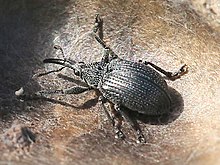Baptisia alba
| Baptisia alba | |
|---|---|

| |
| Baptisia alba var. macrophylla | |

| |
| Baptisia alba var. alba | |
| Scientific classification | |
| Kingdom: | Plantae |
| Clade: | Tracheophytes |
| Clade: | Angiosperms |
| Clade: | Eudicots |
| Clade: | Rosids |
| Order: | Fabales |
| Family: | Fabaceae |
| Subfamily: | Faboideae |
| Genus: | Baptisia |
| Species: | B. alba |
| Binomial name | |
| Baptisia alba (L.) Vent. | |
| Synonyms | |
|
Baptisia lactea (Raf.) Thieret | |


Baptisia alba, commonly called white wild indigo or white false indigo, is a herbaceous perennial plant in the bean family Fabaceae. It is native in central and eastern North America,[1] and is typically found in open woodland areas and prairies with tall grasslands.[2]
The plant is typically 2 to 3 feet (0.61 to 0.91 m) tall, but can be taller, with white, pealike flowers.[1]
There are two varieties, Baptisia alba var. alba and Baptisia alba var. macrophylla.
Description
Leaves have alternate arrangement, and are trifoliate, narrow, and oblong.[3] The leaves are compound and share a common stalk.[4] White flowers occur from a long spike inflorescence. The white flowers that bloom from the spike inflorescence are Paplilonaceous flowers which are identifiable by their irregular shape and five flower petals that have bilateral symmetry.[5] Blooming occurs from April to July, earlier in the southern part of the range.[6] The species is native to grasslands, but is grown in some gardens. It favors moist soils.[3]
Baptisia alba var. alba (syn. B. pendula) can be differentiated from B. alba var. macrophylla (syn. B. lactea and B. leucantha) on the basis that the former occurs only in the southeastern US and has fruits that hang downward when ripe.[7]
Baptisia alba is described as a facultative upland plant in all parts of its range.[8]
Ecology
B. alba is a host plant for caterpillars of the wild indigo duskywing butterfly and the indigo stem borer moth.[9] Bumblebees pollinate the flowers.[10]
Predation
One of the main predators and factors in the reproduction of B. alba are the Trichapion rostrum, commonly referred to as the Wild Indigo Weevil, or Baptisia Seed Pod Weevil which are a type of beetle with an elongated snout that predate on the pre-dispersed B. alba seeds.[11] The Weevils utilize the B. alba flowers and seeds by inserting their eggs into the fruit of the B. alba plant by creating an opening at the base and pushing their eggs into the fruit itself where they feed on the seeds of the plant until they develop and emerge from the fruit.[12] The weevils can be found on the pods of the B. alba, inserting their eggs, just before their pods open up and begin to bloom. The inserted weevil offspring uses the seeds of the B. alba pod while they grow inside the pod until they reach full development.[2] The seed production of B. alba is impacted by seed predation which can cause B. alba to abort damaged fruits that are frequented by predators in order to give more nutrients to healthier seed pods to increase their chance of survival.[12]
Toxicity
The species can be fatal to cows that ingest the plant. It can cause irritation to humans and is possibly poisonous.[6]
References
- ^ a b "Plants Profile for Baptisia alba (white wild indigo)". plants.usda.gov.
- ^ a b Petersen, Chris E., Renee E. Petersen, and Rachel Meek. "Comparison of common factors affecting seed yield in the congeners, Baptisia alba and Baptisia bracteata." Transactions of the Illinois State Academy of Science 99.1 (2006): 31-36.
- ^ a b Denison, Edgar (2017). Missouri Wildflowers (Sixth ed.). Conservation Commission of the State of Missouri. p. 32. ISBN 978-1-887247-59-7.
- ^ Wang, H. C.; Sun, H.; Compton, J. A.; Yang, J. B. (2006). "A phylogeny of Thermopsideae (Leguminosae: Papilionoideae) inferred from nuclear ribosomal internal transcribed spacer (ITS) sequences". Botanical Journal of the Linnean Society. 151 (3): 365–373. doi:10.1111/j.1095-8339.2006.00512.x. ISSN 1095-8339.
- ^ Prenner, G. (2013). "Flower development in Abrus precatorius (Leguminosae: Papilionoideae: Abreae) and a review of androecial characters in Papilionoideae". South African Journal of Botany. 89: 210–218. doi:10.1016/j.sajb.2013.06.008.
- ^ a b "Lady Bird Johnson Wildflower Center - The University of Texas at Austin". www.wildflower.org. Retrieved 2021-04-21.
- ^ "Baptisia (False or Wild Indigo)". ClemsoHome & Garden Information Center. Clemson Cooperative Extension. Retrieved 26 June 2022.
- ^ "Plants Profile for Baptisia alba (white wild indigo)". plants.usda.gov. Retrieved 2021-04-21.
- ^ Robinson, Gaden S.; Ackery, Phillip R.; Kitching, Ian; Beccaloni, George W.; Hernández, Luis M. (2023). "HOSTS - The Hostplants and Caterpillars Database at the Natural History Museum". www.nhm.ac.uk. doi:10.5519/havt50xw.
- ^ "White Wild Indigo (Baptisia alba macrophylla)". www.illinoiswildflowers.info.
- ^ Hembrough, Ashley M.; Borowicz, Victoria A. (2017). "Pre-dispersal seed predation by the weevils Trichapion rostrum and Tychius sordidus limits reproductive output of Baptisia alba (Fabaceae)". Botany. 95 (8): 809–817. doi:10.1139/cjb-2016-0329. ISSN 1916-2790.
- ^ a b Hembrough, Ashley Morgan (2015). Factors Constraining the Reproductive Output of Baptisia alba macrophylla (Thesis). Illinois State University. doi:10.30707/etd2015.hembrough.a.
